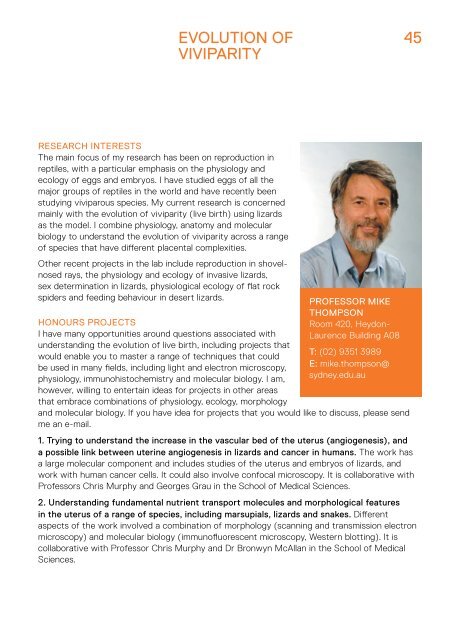biological sciences HONOURs 2014 - The University of Sydney
biological sciences HONOURs 2014 - The University of Sydney
biological sciences HONOURs 2014 - The University of Sydney
You also want an ePaper? Increase the reach of your titles
YUMPU automatically turns print PDFs into web optimized ePapers that Google loves.
EVOLUTION OF<br />
VIVIPARITY<br />
45<br />
Research Interests<br />
<strong>The</strong> main focus <strong>of</strong> my research has been on reproduction in<br />
reptiles, with a particular emphasis on the physiology and<br />
ecology <strong>of</strong> eggs and embryos. I have studied eggs <strong>of</strong> all the<br />
major groups <strong>of</strong> reptiles in the world and have recently been<br />
studying viviparous species. My current research is concerned<br />
mainly with the evolution <strong>of</strong> viviparity (live birth) using lizards<br />
as the model. I combine physiology, anatomy and molecular<br />
biology to understand the evolution <strong>of</strong> viviparity across a range<br />
<strong>of</strong> species that have different placental complexities.<br />
Other recent projects in the lab include reproduction in shovelnosed<br />
rays, the physiology and ecology <strong>of</strong> invasive lizards,<br />
sex determination in lizards, physiological ecology <strong>of</strong> flat rock<br />
spiders and feeding behaviour in desert lizards.<br />
Honours projects<br />
I have many opportunities around questions associated with<br />
understanding the evolution <strong>of</strong> live birth, including projects that<br />
would enable you to master a range <strong>of</strong> techniques that could<br />
be used in many fields, including light and electron microscopy,<br />
physiology, immunohistochemistry and molecular biology. I am,<br />
however, willing to entertain ideas for projects in other areas<br />
that embrace combinations <strong>of</strong> physiology, ecology, morphology<br />
Pr<strong>of</strong>essor Mike<br />
Thompson<br />
Room 420, Heydon-<br />
Laurence Building A08<br />
T: (02) 9351 3989<br />
E: mike.thompson@<br />
sydney.edu.au<br />
and molecular biology. If you have idea for projects that you would like to discuss, please send<br />
me an e-mail.<br />
1. Trying to understand the increase in the vascular bed <strong>of</strong> the uterus (angiogenesis), and<br />
a possible link between uterine angiogenesis in lizards and cancer in humans. <strong>The</strong> work has<br />
a large molecular component and includes studies <strong>of</strong> the uterus and embryos <strong>of</strong> lizards, and<br />
work with human cancer cells. It could also involve confocal microscopy. It is collaborative with<br />
Pr<strong>of</strong>essors Chris Murphy and Georges Grau in the School <strong>of</strong> Medical Sciences.<br />
2. Understanding fundamental nutrient transport molecules and morphological features<br />
in the uterus <strong>of</strong> a range <strong>of</strong> species, including marsupials, lizards and snakes. Different<br />
aspects <strong>of</strong> the work involved a combination <strong>of</strong> morphology (scanning and transmission electron<br />
microscopy) and molecular biology (immun<strong>of</strong>luorescent microscopy, Western blotting). It is<br />
collaborative with Pr<strong>of</strong>essor Chris Murphy and Dr Bronwyn McAllan in the School <strong>of</strong> Medical<br />
Sciences.
















